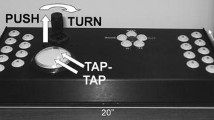Abstract
Although traditional therapies failed, use ofindividualized scripts to remediate executive andvisuo-motor deficits in three patients with frontal andparietal injuries resulted in improved motor sequencing, problem solving, use of left neglectcompensatory strategies, and decreased perseveration andfrustration. Therapists modeled script use with correctmovements. After learning scripts by heart, patients verbalized each move they were to make (overtself-guidance) while carrying out transfers, wheelchairnavigation, and visuo-motor tasks. Finally, patientsrecited scripts silently (internalizedself-guidance).
Similar content being viewed by others
REFERENCES
Abikoff, H. (1985). Efficacy of cognitive training intervention in hyperactive children: A critical review. Clinical Psychology Review, 5, 479–512.
Barclay, L., Zemcov, A., Reichert, W., & Blass, J. P. (1985). Cerebral blood flow decrements in chronic head injury syndrome. Biological Psychiatry, 20, 146–157.
Berk, L. ( 1986). Relationship of elementary school children's private speech to behavioral accompaniment to task, attention, and task performance. Developmental Psychology, 22, 671–680.
Cicerone, K. O., & Wood, J. C. (1987). Planning disorder after closed head injury. Archives of Physical Medicine and Rehabilitation, 68, 111–115.
Grant, D. A., & Berg, E. A. (1980). The Wisconsin Card Sort Test random layout: Directions for administration and scoring.Madison: Wells Printing Co.
Hijdra, A., & Meerwaldt, J. D. (1984). Balint's syndrome in a man with border-zone infract caused by atrial fibrillation. Clinical Neurology and Neurosurgery, 86, 51–54.
Juergens, S. M., Fredrickson, P. A., & Pfeiffer, F. E. (1986). Balint's syndrome mistaken for visual conversion re action. Psychosomatics, 27, 597–599.
Kolb, B., & Whishaw, I. Q. (1996). Fundamentals of human neuropsychology(4th ed.). New York: W.H. Freeman & Co.
Luria, A. R. (1959). The directive function of speech in development and dissolution. Word, 15, 453–464.
Luria, A. R. (1980). Higher cortical functions in man(2nd ed., rev. and exp.; B. Haigh, Trans.). New York: Basic Books. (Original work published 1962)
Luria, A. R. (1981). Language and cognition(J. V. Wertsch, Ed.). Washington, DC: V. H. Winston & Sons.
Meichenbaum, D. H., & Goodman, J. (1971). Training impulsive children to talk to themselves: A means of developing self-control. Journal of Abnormal Psychology, 77, 115–126.
Mesulam, M. (1985). Principles of behavioral neurology. Philadelphia: F. A. Davis.
Parsons, L. M., Fox, P. T., Downs, J. H., Glass, T., Hirsch, T. B., Martin, C. C., Jerabek, P. A., & Lancaster, J. L. (1995). Use of implicit motor imagery for visual shape discrimination as revealed by PET. Nature, 375, 54–55.
Passler, M. A., Isaac, W., & Hynd, G. W. (1985). Neurological development of behavior attributed to frontal lobe functioning in children. Developmental Psychology, 1, 349–370.
Roland, P. E., Larsen, B., Lassen, N. A., & Skinhoj, E. (1980). Supplementary motor area and other cortical areas in organization of voluntary movements in man. Journal of Neuropsychology, 43, 118–136.
Stuss, D. T., & Benson, F. D. (1984). Neuropsychological studies of the frontal lobes. Psychological Bulletin, 953–28.
Stuss, D. T., & Benson, D. F. (1986). The frontal lobes. New York: Raven Press.
Toomis, H. (1995). Brain blood flow and neurofeedback. Unpublished manuscript.
Vygotsky, L. (1962). Thought and language. Cambridge, MA: MIT Press.
Wechsler, D. (1981). Manual for the Wechsler Adult Intelligence Scale-Revised.San Antonio: The Psychological Corporation.
Wechsler, D. (1987). Manual for the Wechsler Memory Scale-Revised. San Antonio: The Psychological Corporation.
Wise, S. P. (1985). The primate premotor cortex: Past, present, and preparatory. Annual Review of Neuroscience, 81–19.
Ylvisaker, M., & Szekeres, S. F. (1989). Metacognition and executive impairments in head-injured children and adults. Topics in Language Disorders, 9, 34–49.
Yoshihiko, N., Olsen, T. S., Larsen, B., & Lassen, N. (1982). Left-right cortical asymmetries of regional blood flow during listening to words. Journal of Neurophysiology, 48, 458–466.
Zamelli, A. J., Stamm, J. S., Maitinsky, S., & Loiselle, D. L. (1977). Auditory evoked potentials and selective attention in formerly hyperactive adolescent boys. American Journal of Psychiatry, 134742–747.
Rights and permissions
About this article
Cite this article
O'Callaghan, M.E., Couvadelli, B. Use of Self-Instructional Strategies with Three Neurologically Impaired Adults. Cognitive Therapy and Research 22, 91–107 (1998). https://doi.org/10.1023/A:1018720120738
Issue Date:
DOI: https://doi.org/10.1023/A:1018720120738




